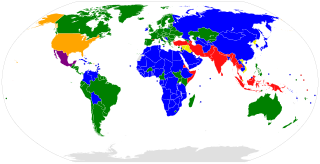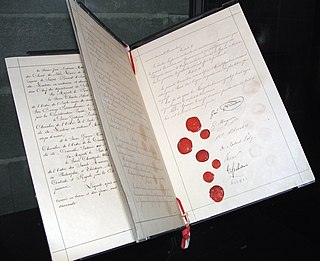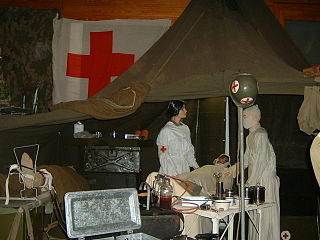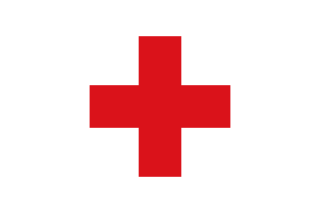
The organized International Red Cross and Red Crescent Movement is a humanitarian movement with approximately 16 million volunteers, members, and staff worldwide. It was founded to protect human life and health, to ensure respect for all human beings, and to prevent and alleviate human suffering. Within it there are three distinct organisations that are legally independent from each other, but are united within the movement through common basic principles, objectives, symbols, statutes, and governing organisations.

The Geneva Convention relative to the Protection of Civilian Persons in Time of War, more commonly referred to as the Fourth Geneva Convention and abbreviated as GCIV, is one of the four treaties of the Geneva Conventions. It was adopted in August 1949, and came into force in October 1950. While the first three conventions dealt with combatants, the Fourth Geneva Convention was the first to deal with humanitarian protections for civilians in a war zone. There are currently 196 countries party to the 1949 Geneva Conventions, including this and the other three treaties.

The law of war is the component of international law that regulates the conditions for initiating war and the conduct of hostilities. Laws of war define sovereignty and nationhood, states and territories, occupation, and other critical terms of law.

Combatant is the legal status of a person entitled to directly participate in hostilities during an armed conflict, and may be intentionally targeted by an adverse party for their participation in the armed conflict. Combatants are not afforded immunity from being directly targeted in situations of armed conflict and can be attacked regardless of the specific circumstances simply due to their status, so as to deprive their side of their support.

Non-combatant is a term of art in the law of war and international humanitarian law to refer to civilians who are not taking a direct part in hostilities; persons, such as combat medics and military chaplains, who are members of the belligerent armed forces but are protected because of their specific duties ; combatants who are placed hors de combat; and neutral persons, such as peacekeepers, who are not involved in fighting for one of the belligerents involved in a war. This particular status was first recognized under the Geneva Conventions with the First Geneva Convention of 1864.

The First Geneva Convention for the Amelioration of the Condition of the Wounded in Armies in the Field, held on 22 August 1864, is the first of four treaties of the Geneva Conventions. It defines "the basis on which rest the rules of international law for the protection of the victims of armed conflicts."

The Magen David Adom is Israel's national emergency medical, disaster, ambulance and blood bank service. The literal meaning of name is "Red Shield of David," but the symbol is more frequently called the "Red Star of David" in many languages. Since June 2006, Magen David Adom has been officially recognized by the International Committee of the Red Cross (ICRC) as the national aid society of the State of Israel under the Geneva Conventions, and a member of the International Federation of Red Cross and Red Crescent Societies. MDA has a dedicated medical emergency phone number in Israel, 101. MDA can become an auxiliary arm of the Israel Defense Forces during times of war. In 2022, MDA became academically affiliated with Ben-Gurion University of the Negev.
International humanitarian law (IHL), also referred to as the laws of armed conflict, is the law that regulates the conduct of war. It is a branch of international law that seeks to limit the effects of armed conflict by protecting persons who are not participating in hostilities and by restricting and regulating the means and methods of warfare available to combatants.

Protocol I is a 1977 amendment protocol to the Geneva Conventions concerning the protection of civilian victims of international war, such as "armed conflicts in which peoples are fighting against colonial domination, alien occupation or racist regimes". In practice, Additional Protocol I updated and reaffirmed the international laws of war stipulated in the Geneva Conventions of 1949 to accommodate developments of warfare since the Second World War (1937–1945).

A combat medic is responsible for providing emergency medical treatment at a point of wounding in a combat or training environment, as well as primary care and health protection and evacuation from a point of injury or illness. Additionally, medics may also be responsible for the creation, oversight, and execution of long-term patient care plans in consultation with or in the absence of a readily available doctor or advanced practice provider. Combat medics may be used in hospitals and clinics, where they have the opportunity to work in additional roles, such as operating medical and laboratory equipment and performing and assisting with procedures.

Protocol II is a 1977 amendment protocol to the Geneva Conventions relating to the protection of victims of non-international armed conflicts. It defines certain international laws that strive to provide better protection for victims of internal armed conflicts that take place within the borders of a single country. The scope of these laws is more limited than those of the rest of the Geneva Conventions out of respect for sovereign rights and duties of national governments.

Under the Geneva Conventions, the emblems of the International Red Cross and Red Crescent Movement are to be worn by all medical and humanitarian personnel and also displayed on their vehicles and buildings while they are in an active warzone, and all military forces operating in an active warzone must not attack entities displaying these emblems. The International Red Cross and Red Crescent Movement recognizes four protection emblems, three of which are in use: the Red Cross, the Red Crescent, the Red Lion and Sun, and the Red Crystal.
In the context of war, perfidy is a form of deception in which one side promises to act in good faith with the intention of breaking that promise once the unsuspecting enemy is exposed.

The International Committee of the Red Cross is a humanitarian organization based in Geneva, Switzerland, and is a three-time Nobel Prize Laureate. The organization has played an instrumental role in the development of rules of war and promoting humanitarian norms.
Protective signs are legally protected symbols to be used during an armed conflict to mark persons and objects under the protection of various treaties of international humanitarian law. While their essential meaning can be summarized as "don't shoot" or "don't attack", the exact conditions implied vary depending on the respective sign and the circumstances of its use. The form, shape and color of these signs are defined by the rules of international humanitarian law. Usually, they are easy to draw in order to make even an improvised use as easy as possible, and they were chosen to be as concise, recognizable and visible as possible under all circumstances.
The Rule of Law in Armed Conflicts Project is an initiative of the Geneva Academy of International Humanitarian Law and Human Rights to support the application and implementation of the international law of armed conflict.

The Geneva Conventions are international humanitarian laws consisting of four treaties and three additional protocols that establish international legal standards for humanitarian treatment in war. The singular term Geneva Convention colloquially denotes the agreements of 1949, negotiated in the aftermath of the Second World War (1939–1945), which updated the terms of the two 1929 treaties and added two new conventions. The Geneva Conventions extensively define the basic rights of wartime prisoners, civilians and military personnel; establish protections for the wounded and sick; and provide protections for the civilians in and around a war-zone.

Protected persons is a legal term under international humanitarian law and refers to persons who are under specific protection of the 1949 Geneva Conventions, their 1977 Additional Protocols, and customary international humanitarian law during an armed conflict.

The Army Medical Service is a non-combat specialty branch of the German Army traditionally responsible for providing medical services within the army, and which has a humanitarian function during armed conflicts in accordance with international humanitarian law, and specific rights and responsibilities under the Geneva Conventions, their additional protocols and customary international humanitarian law. It is entitled under international humanitarian law to use the red cross as a protective sign and its personnel are protected persons under international humanitarian law. Since 2002, most of its former responsibilities have been transferred to the Joint Medical Service. The Army Medical Service still exists as a small entity within the German military.

Basic human rights in Italy includes freedom of belief and faith, the right of asylum from undemocratic countries, the right to work, and the right of dignity and equality before the law. Human rights are the basic rights of every citizen in every country. In Italy, human rights have developed over many years and Italy has education on human rights. In addition, Italy has specific human rights for women, children and LGBT people.
















